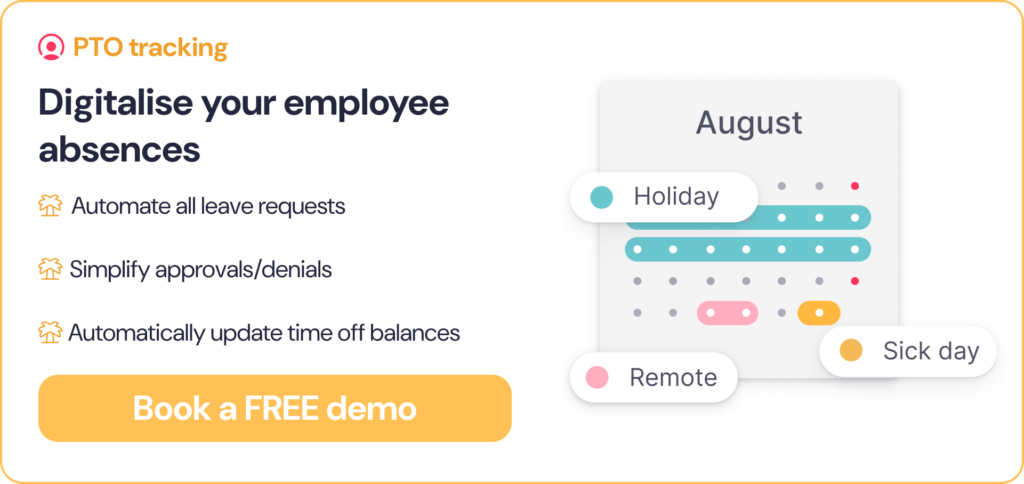There are various types of leave that employers can offer to their employees, including holiday leave, sick leave, bereavement leave, time in lieu and garden leave. There is also another less common type of leave that increasing numbers of businesses choose to offer as an employment benefit: sabbatical leave.
Although historically, only a small percentage of non-academic businesses offered paid or unpaid sabbatical leave, this figure has been on the rise since the start of the pandemic, according to Forbes. The main reason for this is that sabbatical leave can be a great tool for preventing employee burnout and increasing retention levels.
So, what is sabbatical leave? Should it be paid or unpaid? Who is entitled to take it? And what do you need to consider when you design your sabbatical leave policy?
These are just some of the questions we will be addressing below.
What is a Sabbatical Leave?
Let’s start with the meaning of sabbatical leave.
Sabbatical leave is an extended period of paid or unpaid leave that companies can offer to eligible employees. There are no laws relating to sabbatical leave. Whether or not an employee is eligible will depend on the company policy. It also usually depends on the length of service and an employee’s reasons for requesting an extended leave of absence.
Employees can request a sabbatical for a number of personal and professional reasons including travel, study, volunteering, or spending time with family. Traditionally, sabbatical leave has been a benefit reserved for academic environments, but many other industries are nowadays choosing to adopt similar policies. As sabbaticals can combat reduce burnout, increase retention levels and improve employee satisfaction rates.
However, sabbaticals are not holidays or a means to prevent post-holiday blues. Nor are they the same as a career break. The main reason for taking a sabbatical is studying or training to advance career prospects.
This means that it doesn’t just benefit the health and wellbeing of employees; it also boosts the overall development of a company’s knowledge and skill sets.
Are Sabbaticals Paid?
Paid sabbatical leave just means that an employee is being paid – partially or in full – for the duration of their absence. As opposed to obligations enforced by sick leave legislation, if you offer sabbaticals to certain employees it is up to you whether or not you classify it as paid time off.
There are a number of benefits to offering full or partial pay to employees that take a sabbatical leave:
- Your employees have time to learn new skills, gain knowledge and experience that they can bring back to your company.
- A sabbatical leave policy can help you foster a personal development culture. It also highlights that you provide career growth opportunities, which can help improve employee satisfaction and motivation levels.
- The happier and more motivated your employees are, the higher your rate of retention will be. This is because employees value that you support them in all their goals (professional and personal time off).
- Happy employees also result in lower turnover rates. Given that turnover costs companies a lot of money for every new hire, offering sabbaticals to certain eligible employees can be much more cost-effective in the long run.
- It’s a great perk that can help you attract top talent.
- Employees have time to de-stress. This means they come back refreshed, reinvigorated, and more motivated.
How Long is a Sabbatical Leave?
The length of a sabbatical leave period depends on you. The sabbatical leave is usually longer than a standard employee holiday, which means usually at least four to six weeks. It should also be less than a year, which would generally be construed as being more of a career break.
The leave duration that you offer will probably also depend on an employee’s years of service. For example, Adobe offers four weeks of leave to employees that have been with the company for at least five years, five weeks to those who have been employed for ten years and six weeks to those who have been working with them for more than 15 years.
It is up to you to decide what works best for your organisation. Whatever you decide, you should ensure all terms are clearly defined in your sabbatical/sickness and absence policy.
What is a Sabbatical Leave Policy and How to Set It Up?
As an employer, you will receive many types of time off requests. It’s important to create separate policies for each absence type. For example, you should have a defined policy for employee annual leave that details the procedure for absence management and the method you use for tracking employee absences. You might use time tracking software, or use a template such as our free 2022 Time Off Tracker Template.
The same applies to sabbatical leave, whether it is paid or unpaid. You need to clearly define all your sabbatical leave rules and procedures so that there is no confusion later.
Let’s look at some of the things you need to keep in mind when creating your unpaid or paid sabbatical leave policy.
Paid Sabbatical Leave Policy
There are a number of crucial aspects that you will find in a model sabbatical leave policy. For example, you need to make sure you clearly define key elements relating to eligibility, whether or not employees are paid during a sabbatical, and the duration of leave that employees can request.
Are all employees eligible for paid sabbatical leave? Is there a minimum length of service? What reasons can they give for requesting leave? Does it have to be for professional reasons or will you offer paid leave for personal reasons too? Will they get full or partial pay? If you are paying for an employee to take paid sabbatical leave, will they need to remain at your company for a specific length of time after their return?
The key to success is clarity and transparency.
Unpaid Sabbatical Leave Policy
The same advice applies if you are creating an unpaid sabbatical leave policy. Even if you don’t pay an employee on sabbatical, you will still classify them as an employee, so you must define your expectations and their obligations clearly. For example, employees are still bound by harassment, confidentiality, and data protection policies whilst on unpaid sabbatical leave.
Another aspect to consider is whether employees can combine leaves. For example, can an employee take maternity leave and then extended it with an unpaid sabbatical? Or can they add an unpaid sabbatical to a family medical leave to care for a sick relative?
It’s important that you consider all these aspects when offering a paid or unpaid leave of absence.
What is a Sabbatical Program?
Drafting a comprehensive sabbatical policy is important, as it sets out the rules, conditions, and eligibility for sabbatical leave. It doesn’t stop there though. You also need to nurture the right culture so that the initiative is a success.
This is where a sabbatical program comes in.
A sabbatical program helps you create the right environment for your initiative to flourish. It helps you communicate the benefits of the program and the support that employees will receive. And for your program to work, all your managers must be on board.
Your managers should take an active role in identifying potential candidates for sabbaticals. Who would benefit from a period of extended leave for professional development? By actively promoting your policy and engaging employees you are far more likely to benefit from a successful program that boosts productivity and morale.
Do All Companies Offer Sabbatical Leave?
Sabbaticals aren’t right for every company. Whether or not it would work for you will depend on a number of aspects.
For example, budget is a huge concern for many companies. That is why sabbaticals tend to be offered by larger, more established companies rather than start-ups with limited resources. And even if you have the resources, it may not necessarily be a good fit for your business model.
On the other hand, companies of all sizes that are experiencing high turnover may consider implementing a sabbatical program and other flexible work options. These programs may successfully reduce turnover costs and improve employee morale.
If you are still not sure, then consider the following:
- Your goal: what do you hope to achieve by offering paid or unpaid sabbaticals?
- How will you measure the success of the program? For example, will you track metrics relating to retention or development?
- If an employee takes a sabbatical, how will it impact the various teams and departments in your company? Will you hire temporary replacements or distribute workloads amongst other employees?
- How will you define eligibility? By seniority or years of service?
- How much will it cost you vs how much will you save? For example, if you only offer sabbatical leave for professional development, what ROI do you expect to receive?
- You also need to calculate the cost of sabbaticals vs the cost of turnover. Will the benefits you receive outweigh the cost of offering paid or unpaid sabbatical leave? Make sure the cost of an employee’s development is worth the investment.
Time Management with Factorial
Utilize Factorial for all your time tracking needs: hourly timesheets, employee absences, PTO requests, etc. This all-in-one HR platform is a robust software to centralise and automate all your HR admin tasks. It’s designed to increase your company’s efficiency while being user-friendly.




